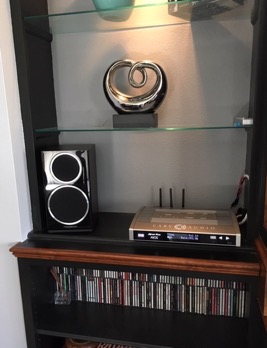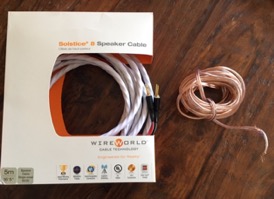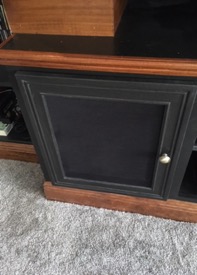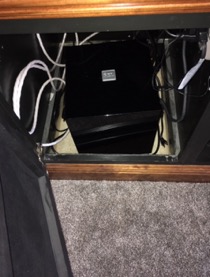What if Cary Audio produced a network streamer/DAC with Ethernet and Wi-Fi for just under $1500 that had all the same capabilities as our DMS-500/550/600 platform that NO competition could touch anywhere near its price?
What if Cary audio had a Class AB fully discrete 75 x 2 integrated amplifier with heavy duty toroidal power supply for just under $1500 that was built off the same circuit as our 200-watt SA-200.2/200.2ES amplifiers producing true Cary Audio audiophile level sound?
Sounds interesting, right? $10,000 worth of audio gear for just $2995. Now, add in a preamp section with preamp outputs, subwoofer output, processor loop, dynamic sliding volume control, and 3 analog inputs. Throw in a full MQA decoder and Roon Ready for good measure. Did I mention the DAC can stream DSD512, PCM 32/384, and has optical and coaxial inputs and outputs plus 3 USB-A inputs for connecting USB devices as well as a SD card slot? It can also upsample to 7 different upsample rates up to 768k or convert PCM to DSD and even upsample lower DSD rates up to DSD256. What else? The DAC also has two-way aptX™ Bluetooth for either transmitting BT from your phone or tablet or for sending BT to BT enabled headphones or speakers. And yes, it also has Airplay.
All this sounds too good to be true, but in fact, it is true. Now, take that $1500 network Streamer/DAC and $1500 Class AB integrated amplifier and put it in a single all aluminum compact chassis and call it AiOS. AiOS streaming amplifier is NOT a toy or a cute knock-off or an OEM piece of gear. It is truly our full DMS platform mated with a true Cary Audio amplifier. You couldn’t get these items in separates with the same capabilities and sonic characteristic anywhere near this price. Don’t be fooled by its value or size. AiOS is the real deal and a Cary Audio engineered and manufactured product from the ground up.
Now that we’ve established the value of AiOS, I want to talk about synergy. One or the other is something that is always appreciated when found. However, when one hits upon both value and synergy, it’s particularly pleasing!
Diamonds are Precious
I’ve been a steadfast proponent of AiOS since it was first released. Knowing the engineering and sonic prowess that went into it, it’s easy to appreciate on many levels. Recently, I touched upon a synergist combination of value and performance that has floored me. First, let me preface this by saying I’ve used lots of various speakers at various shows with AiOS. All with great success. I’ve used $500 to $5,000 British, German, Canadian, and American floor standers as well as $279 to $3000 monitors from the same parts of the world. All have been fantastic, some more so than others. However, recently I decided to try a pair of Wharfedale Diamond 220 monitors. They retail for just $350 per pair but I’ve seen them as low as $250. They are a compact 5” two-way monitor with 1” dome tweeter ported design. Typically, I prefer sealed enclosures. However, the Diamond design uses a bottom mounted port that fires down towards a narrow plinth with an even narrower gap in-between. This makes them easy to place as you can see in my photo. This is a “real world” setup. No room treatment or special tweaks. Basically, a set it and forget it setup. The speakers are not optimally placed and probably a bit too far apart. But again, it’s a real-world environment. Coincidently, the 2018 December edition of The Absolute Sound gave its bigger sibling product of the year for affordable speakers. Those were the Wharfedale Diamond 225 which uses a larger 6 ½” mid-bass with the same 1” dome tweeter in a slightly larger cabinet. Those retail for $449 per pair. Given my experience with the 220s I’d have to agree with The Absolute Sound’s assessment and award. What the 220s achieve paired with AiOS in contrast to other speakers I’ve use up to the $2500 mark is remarkable. The Wharfedale Diamond 220s bring out the best of AiOS and AiOS the best of the Wharfedales. Soundstage is vast. High, wide, and deep. Imaging is fantastic. Bass, yes bass, for its 5” mid-bass is present and tuneful. Not earthshattering bass, but bass texture and tunefulness are far beyond its size given the right source material. What really sets it apart is its overall sheer musicality and smoothness along with a VERY natural midrange that is just a pleasure to listen to. Recording and source material is everything and the better the source material the bigger and better the sound from the Diamond 220s. That’s not to say average recordings don’t sound good on the Diamond 220s. They do. But, feed it a great recording and the sound quality of the Diamond 220s really skyrocket. That is a testament to a great speaker in that it doesn’t plateau. Additionally, all Tone and EQ controls were set and remained OFF in AiOS when listening with the Diamond 220s. I can’t say the same with most other mini-monitors I’ve used in an attempt to get them to sound a bit fuller bodied and balanced. The Wharfedale Diamond 220s on almost everything I’ve listened to have an uncanny ability to sound full and balanced. Track after track. Genre after genre. Day after day, the AiOS and Diamond 220 combination has been nothing short of fun and flat out REALLY GOOD. The one criticism I have is at times the Diamond 220s could sound a bit boxy or congested with some source material in the upper bass lower mid. On such occasions I would tell myself, “it’s just a $350 speaker, what do you expect.”

The Space In-Between
I like to think of cable as an audio component. No point spending good money on the rest of the gear and tying it all together with cheap wire. That said, be prudent. Cost is never indicative of quality and there are never any shortcuts, even with cable. Using a cable that just “works” vs. one that lets your system shine is like chopping your system off at its knees. It’s also important to keep the cable in-check with the rest of your system.
The AiOS and Diamonds were setup on a built-in that was prewired with standard generic 18-gauge cable. At one point, I free-wired the speakers with no-thrills Belden cable from Blue Jeans. All the above listening and impressions were with these two cables and it was quite good, really good, actually. I felt the Belden was a bit better, but not to an astonishing degree. Since the AiOS has built-in Wi-Fi, no special wiring is needed for it. Just power! With Wi-Fi I can access all my computer stored music and internet music services like Spotify and TIDAL with ease and simplicity. AiOS is incredibly flexible and easy to use. I sometimes have to remind myself that everything I’m doing is from an all-in-one wireless product with no installation or setup required.

Not to be content just yet, I decided to try one more speaker cable. I wanted to keep the speaker cable real with regard to the price of the speakers and AiOS. I’ve used Wireworld Cable at many shows with great success. So, I decided to upgrade from the 18-gauge generic and Belden cable to the Wireworld Solstice 8. An 8ft. pair retails for $160. That’s very reasonable considering the Belden cable retails for about $80, especially considering…
Lightning
After a mere few seconds of replacing the 18-gauge cheap-O and the Belden cable with the Wireworld Solstice 8 I was like, WOW! Granted, $160 for speaker cable is not cheap, but it was more than worth it. I can’t think of any other addition to this system for just $160, even upgrading to the Wharfedale Diamond 225s with generic cable, that would make such a true dramatic positive effect on the sound. Everything I loved as mentioned above was even better. EVEN more musical, EVEN better bass and more of it. EVEN the sometimes-boxy nature all but disappeared. This system went from really good to unbelievably good. That’s not EVEN considering the value and price of the system. What awestruck me was the pure sense of ease and absolute coherence and surefootedness due to the introduction of the Solstice 8 speaker cable. Musically, this modest system is easily beyond double the cost of its components. With the Solstice 8 cables it revealed just how good AiOS’ DAC and amplifier are. Hi-Fi Choice said of AiOS in a recent 5 out of 5-star review, “It’s quite easy to confuse this [AiOS] for a full-sized hi-fi separate, so good it is.” That’s exactly right. The Solstice 8 also allows the Diamonds to show just how good they can be when paired with the right combination of electronics and cable.

Just to make sure I wasn’t making much ado about nothing, I took the Diamonds up to my reference system costing many, many times more than the real-world AiOS, Wharfedale, Wireworld combination. Not to my surprise, the Diamonds sounded good on my main rig. However, I dare say not quite as enjoyable overall as when paired with AiOS and the Solstice 8 cables. This is where synergy comes into play. For whatever reason, the diamonds on a larger system didn’t wow me like they did with AiOS and Solstice 8 system. Synergy is real and lightning struck. I derived so much pleasure listening to this system that in a way, it’s more fun than my reference system. I believe part of the reason for this is that I personally get immense pleasure creating affordable systems that punch way above their weight class. There is also something to be said for simplicity. Just three simple components, AiOS at $2995, Wharfedale Diamond 220 at $350 per pair, and Wireworld Solstice 8 speaker cable at $160 for an 8ft pair. This fantastic system totals for just $3500 at full retail.
For a total complete system costing just $3500 at retail, I can’t stop listening to it. It’s just utterly and absolutely pure musicality and worth every penny at full retail. With the Wireworld Solstice 8, bass became much more palpable and satisfying. A lot more so than one would expect from just a 5” mid-bass. AiOS’ ability to convey true natural detail, smoothness and texture is quite remarkable, ESPECIALLY considering its value as both a network streamer/DAC and as an integrated amplifier. Combined with the value and attributes of the Wharfedale’s ability to sound quite mature in conjunction with Wireworld Solstice 8’s ability to convey pure cohesiveness, makes for a particular pleasing system. The fact it’s so affordable makes it that much more enjoyable.
Thunder
I listened to all genres of music and seldom did I ever find an overwhelming desire or wanting for more bass. Perhaps this is due to speaker placement close to walls and corners. This is again a real testament to the Diamond’s ability to sound so satisfying and unfussy. Only on occasion did I find a slight urge for more bass. If room shaking bass isn’t your thing and you can place the diamonds near a rear wall, you’ll most likely be generally satisfied. If you do desire more bass, as in the lower octaves and texture to round out to more of a full range speaker system, I have the thunder! For a retail price of only $599, the REL T5i powered subwoofer even further stretches the unfathomable performance of this system to yet a new level. I placed (threw in, more like it) the 8” REL into the cabinetry as shown in the picture. Once again, some systems are meant to be real-world and this one is for sure. No special placement and frankly, using a down firing subwoofer inside a cabinet such as this is not optimal to say the least! Once dialed in as best as I could, given the circumstances, bass was awesome. The foundation it added was remarkable. Indeed, it sounded more like a full range speaker system EASILY in the $2500+ range. $948 worth of speakers and sub sounding well beyond that of a full size $2500+ speaker. Seriously! Not only is the bass tuneful and musical, but midrange depth and clarity were further evident. Part of the reason for such tuneful and prodigious bass, when called upon, is due to the REL’s hook-up and the AiOS amplifier. REL recommends, as do I, connecting the sub directly to the AiOS’ speaker posts using REL’s Neutrik Speakon high level connection. This allows the Wharfedales to run full range and the REL to receive the AiOS amplifier signal for internal amplification by the REL. This allows the subwoofer and the Wharfedales to receive the same signal straight off AiOS’ amplifier, which greatly contributed to a unified sound with fantastic bass articulation and timbre thanks to AiOS’ sonic characteristics. It’s worth noting that taking the time to properly place the sub, i.e. not in a cabinet, and tune it properly, the bass will even further improve. Take the time to do it and the payoff will be quite rewarding. Larger rooms may require a large sub such as the REL T7i to properly pressurize the room.


Just Enjoy
To sum up, the AiOS, Wharfedale, and Wireworld system at only $3500 brings to bare more high fidelity and musicality than anyone has the right to expect. Going one step further and adding the REL for a system total of just over $4000 for near full range sound adds even greater value. I’ve spent no time tweaking, fine tuning bass, or cable management (as evident in the photos). As I’ve said, this is all based on a real-world “install” and setup. I can only imagine if someone had A) a room optimized for speaker placement with room treatments, etc., or B) took the needed time to properly place and dial-in the REL subwoofer. It only gets better from here folks, so take some time to experiment with placement and tuning as best and realistically as you can, but don’t go nuts. The objective here is to enjoy and not fuss.

It’s not often one comes across such a synergistic combination of components with such a value to performance ratio. If you are someone that just loves to enjoy music and sound without over critiquing and can appreciate a value, check out this combination. It’s perfect as a main system for most music lovers or for the moderate audiophile. It’s also ideal as a secondary system.
If you are located within the United States and Canada, you can purchase AiOS directly from our factory.
If you are located outside the United States and Canada, you can find your local dealer/distributor here.
�





